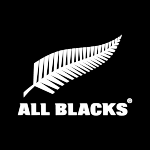 They made complaining an art form. Almost all reports of the 1976 tour -especially the fourth test- starts and ends with a grumble about the refs. The whining began round about the third match, picked-up in intensity after losing against WP and spiraled out of control after the loss against Northern Transvaal and then reached heights of stratospheric proportions after the fourth test defeat.
They made complaining an art form. Almost all reports of the 1976 tour -especially the fourth test- starts and ends with a grumble about the refs. The whining began round about the third match, picked-up in intensity after losing against WP and spiraled out of control after the loss against Northern Transvaal and then reached heights of stratospheric proportions after the fourth test defeat.
No one showed-up at Jan Smuts to wave the All Blacks farewell; no doubt fed-up with all the bitching, complaining and the super superior know-it-all-attitude of this Kiwi tour group regarding South African rugby, refereeing and how the country should be run. Maybe I am over re-acting a bit here but it is hard to fathom how the South African public, media and rugby board could have maintained high levels of positivity regarding this All Black team when one reads how they reacted after the fourth test defeat.
One get the impression that this ’76 team –if not the team then at least the kiwi media- was so busy analyzing South African politics, people, referees, and rugby that they forgot to pay attention to their own game. Very little mention, if any, is made of the fact that this team lost 6 out of 24 games; that they couldn’t kick a penalty even if their lives depend on it; that they totally relied on individual brilliance to score tries, and that they lacked depth in a number of key positions.
This team lost the fourth test and the series because they struggled to construct tries. They scored two tries in the fourth test thanks to the individual opportunistic brilliance of Sid Going and came close on two occasions thanks to the opportunistic individual brilliance of Bruce Robertson. In the second test Joe Morgan received a lucky packet try through some awful Springbok midfield defense. In the first test Jaffray scored after opportunistic individual brilliance by Grant Batty. In the third test Bruce Robertson scored a controversial kick-through-try -thanks to a series of mistakes by the South African wingers- but the team was glaringly unable to manufacture a try in that test; in fact they were so incapable when moving the ball down the backline that Johan Oosthuizen scored the winning try from a ‘intercept’ when the ball bounced off Kit Fawcett’s shoulder on the one occasion they did try to run the ball.
This fact –that they couldn’t construct a decent try in the test matches and against the better provincial sides- is never mention whenever you read about this ’76 All Blacks. The main trust during interviews with players and in reports about this tour is how they were cheated by Gert Bezuidenhout; how poor the South African referees were; how South African rugby was relying on kicks and penalties to win test matches and how the kicking game dominated in South African rugby.
The Springboks traditionally play a structured 10-man style rugby and stayed true to this style in ‘76; Bosch did dominate this era with his kicking; the referees probably were a bit one eyed; the white population were creatures of Apartheid propaganda but this ’76 New Zealand team did not deserve to draw the series just because they played well in the last test. In spite of Bosch and our kicking game South Africa constructed two brilliant tries in the first test, missed out -thanks to a great Peter Whiting tackle- on a outstandingly well constructed try by Boland Coetzee in the second test and scored a well thought out try by Klippies Kritzinger in the fourth test.
The All Black pack was the better forward pack in the fourth test. They dominated in scrums, line-outs and at the rucks –especially in the second half- but the team was inherently flawed in its ability to build tries. Every time they played decent opposition (Western Province, Northern Transvaal and Free Sate) this inherit flaw cost them the match. They had close encounters against Transvaal and the Quagga-Barbarians due this same flaw and only won those matches thanks to some awful kicking by Bosch (Transvaal) and some opportunistic tries by Williams (Transvaal) and Joe Morgan (Babaas).
After having read three accounts by New Zealand authors of this series I have to conclude that the New Zealand reports of this series are just as unconsciously biased and flawed in accurate analysis of New Zealand rugby than they report South African referees and rugby to have been. The great Terry McLean alluded to this fact on a couple of places in his brief about this test match –and at some other places- in his book “Goodbye to glory. This is what he writes about the fourth test with specific reference to the rugby the All Blacks of ’76 played:
They died by their own hands, that was the inevitable verdict. True, Bezuidenhout was unconscionably incompetent in at least three incidents which undoubtedly turned the game –and the series- to South Africa.
He then goes on and elaborates about everything Bezuidenhout did wrong with emphasis on the two times that Bruce Robertson was obstructed from scoring; the South African lifting tactics in the line-outs; and the final penalty against Bush –who was nowhere near the ball- for barging in the line-out.
A penalty which Bosch converted and which won the test and series for South Africa.
He also mentions that quite a number of prominent South Africans including both the English and Afrikaans radio commentators (Chick Henderson and Gerhard Viviers), John Vorster and Danie Craven admitted that the second obstruction of Bruce Robertson should have been a penalty try.
After all this he comes back to the way New Zealand played and their post-match whining:
Such a pity, the caterwauling; because it did distract from the fact that Going twice failed with attempts at conversations by slicing across the line of flight like a golfer hitting from the outside in –the wind was with him, they were kicks as easy (if, to be fair, any goalkicks in any test match are easy) as the two he missed in the Third test; that Williams twice missed downwind two admittedly full-length kicks, one of which Bosch knocked on under his own bar; that Leslie seriously misread the situation at the Kritzinger scrummage; and that worst of all, the All Blacks took until the second half, having taken the wind in the first by choice, before they began to exert their talents in running the ball away from the giant Springbok pack.
After explaining that Williams and Going should never have been allowed to handle the goal kicking he opinionates that the All Blacks did not inspire confidence running with the ball. That was so even though Robertson was clearly the star back in South Africa and the fact that Williams was still –even though lacking the speed he showed in 1970- very dangerous with ball in hand. The All Blacks also persisted with a “curious childlike belief in the value of midfield trusts”, according to McLean. He continuous:
These (midfield trusts) looked glamorous. But the looks were no better than skin deep. Morné du Plessis, often playing forward of the last line of feet, and Whipp and Oosthuizen formed a triad of defenders even the genius of Michael Gibson would seldom have beaten. These three, with their sever tackles, were the principal instruments of South Africa’s admittedly slightly murky glory. They had ardent supporters in such as Boland Coetzee, ever a faithful hand, and in Germishuys; and, of course, with Bosch to hand, they were assured that at the right opportunities there would be right reactions.
McLean also has this paragraph in his narrative about the fourth test:
So to the darkness of disputation and defeat by the All Blacks. Their press conference the next day, which was taken by Stanley, John Stewart and Leslie, was a rumble and grumble of discontent. Forty-eight hours later, when they reached Auckland, the All Blacks exploded. Re-exploded might be the more apt word; they had been going off like rockets since no-side. Nothing would persuade them that they had been unfairly deprived of victory. Stewart made damning statements about South African Rugby which winged over the wires to the press of the Republic and which, looked at there, left no very favorable impression of Kiwi sportsmanship.
The velocity of Kiwi grief after the match was so overwhelming that Springbok complaints were totally ignored, swiped off the table as totally irrelevant within the “larger” issues (read kiwi grousing) at stake. Nobody wanted to listen, consider or debate the validity of South African complaints that Bezuidenhout’s fixation –because of kiwi moaning and groaning after the previous test- with preventing a repeat of the front row collapsing in the 3rd test actually nullified any Springbok advantage in the scrums.
The Kiwi goalkicking deficiencies and the refereeing controversies aside, the fact that the tourists won so much usable ball, had so many try scoring opportunities yet failed to convert possession advantage and opportunity -in both the first and last test- into tries remain the most perplexing feature of this tour. Even more perplexing, for me, is the denial or inability of the kiwi rugby scribes to see and acknowledge this fundamental flaw (inability to built or construct tries and tactically adjust against good opposition) as the primary reason why the class of ’76 lost the series against South Africa.
18 September 1976 – South Africa 15 / New Zealand 14
The All Blacks did not impress after their loss in the third test. They won two mid week games (Upington and Kimberley) but did not really outshine weak opposition. They also looked lethargic and got drawn into some hustle and bustle in both games raising question about their focus and psycho-emotional equilibrium after 24 weeks on tour. They also lost against Orange Free State (15-10) in their only Saturday match. This gave rise to serious doubts about their ability to draw the series as they did not impress as a team which possessed the necessary motivation, cohesiveness and desire to take on a Springbok pack that dominated them in the third test.
The All Black test selection featured several changes to the line-up. Duncan Robertson was back on fullback after an uninspiring performance in that position in the first test. Two star performers during the second test namely Doug Bruce was back on flyhalf with Kevin Eveleigh replacing Ken Stewart on the side of the scrum. Frank Oliver was in at lock in the place of Hamish Macdonald for consistent good performances during the tour and a sterling game in Kimberley. Kent Lambert switched to loose head allowing Billy Bush to regain his place at tight head prop.
Dawie Snyman who did not impress in the second and third tests was replaced by Ian Robertson in the Springbok team. The big surprise and talking point was however the inclusion of a clearly overweight and unfit Klippies Kritzinger in the place of Theuns Stofberg.
Teams
No |
South Africa | New Zealand | |||
| 15 | Ian Robertson | Duncan Robertson | |||
| 14 | Gerrie Germishuys | Bryan Williams | 1 pen | ||
| 13 | Johan Oosthuizen | Bruce Robertson | |||
| 12 | Peter Whipp | Joe Morgan | |||
| 11 | Chris Pope | Grant Batty | |||
| 10 | Gerald Bosch | 1 drop, 1 con, 2 pen | Doug Bruce | 1 drop | |
| 9 | Paul Bayvel | Sid Going | 1 try | ||
| 8 | Morné du Plessis (C) | Andy Leslie (C) | |||
| 7 | Klippies Kritzinger | Kevin Eveleigh | |||
| 6 | Boland Coetzee | Ian Kirkpatrick | 1 try | ||
| 5 | Moaner van Heerden | Peter Whiting | |||
| 4 | Kevin de Klerk | Frank Oliver | |||
| 3 | Rampie Stander | Billy Bush | |||
| 2 | Piston van Wyk | Tane Norton | |||
| 1 | Johan Strauss | Kent Lambert | |||
| South Africa | New Zealand | ||||
| Penalties | 7 | 5 | |||
| Lineouts | 11 | 18 | |||
| Rucks | 3 | 8 | |||
| Tightheads | 0 | 2 | |||
| Replacements | Mitchell for Batty after 67 minutesOsborne for Morgan after 72 minutes | ||||
| Referee | Gert Bezuidenhout (Transvaal) | ||||
| Crowd | 75 000 | ||||
| Venue | Ellispark | ||||
Where the scatting criticism and nationwide condemnation motivated the Springboks to a pitch in the third test the backs-to-the-wall situation confronting the All Blacks inspired one of the most courageous efforts by an All Black team in a final test of a four test series in South Africa.
There can be little doubt that the supreme post-match disappointment and supreme reaction exhibited by the team was directly related to the supreme effort they made to lift themselves to honor the supreme pride and respect they harbored for the traditions of their All Black rugby heritage. The All Blacks pitched-up and the result was that the rugby they dished-up was by far the best of the series. The New Zealand forwards in particular produced a performance that far outweighed the efforts by the backs. Terry McLean writes:
The New Zealand game plan warranted a deep examination because it suggested that the players had gone into the match not quite geared to its demands. So was wasted the mighty work of the forwards. At the line-out, they lagged 6-10 at the half. At the end, they had won 18 to 11, a magnificent achievement. Strauss, the iron man, was no problem to Lambert, who, in his own right, was a bit of an iron man himself. Norton took two heels from van Wyk and, powered by a scrum to which every man contributed a quality much superior to the standard reached by the backs.
Whiting reached and delivered, Oliver, though much outweighted, was not outscored by de Klerk, and among them the back row men, Eveleigh, Leslie and Kirkpatrick, finished the game just short of exhaustion because of their valorous following, tackling, mauling and rucking.
This was a mighty display by the forwards, one of the great events of the tour, and it was a grief and sadness that it was not suitably rewarded. But then, if a team in a test does not take its chances, who should it blame? The referee, as the All Blacks did, to a man, did? Or themselves, which they failed to do?
The Al Blacks took an early lead when Going slipped blindside from a scrum near the left hand touchline after outfoxing Paul Bayvel with a dummy pass. He advanced several meters before Gerald Bosch got hold of his right arm but he was able to shift the ball to Norton as Bosch pulled him down. Norton gave two steps before pushing the ball to Kirkpatrick in the open wearing number 4 on his back. Kirkpatrick running hard sidestepped to his left a few yards from the goal line and went over close to the corner flag with Moaner van Heerden and Ian Robertson crashing in short like two 747 Boeing’s coming in too fast and too steep without their landing gear on.
Bosch landed a superb 40 meters drop goal two minutes later to put South Africa on the scoring sheet.
Neither side where able to achieve dominance in the next 20 minutes with play ebbing up and down on the field. After 30 minutes Going slipped around the open side from a maul close to the Springboks goal line and ducked again under tackles of Boland Coetzee and Kritzinger to score about eight meters from the right hand corner flag. The conversion taken by Going was unsuccessful.
This series of pictures shows Sid Going scoring his try after 30 minutes of play in the first half by ducking under Coetzee and Kritzinger.
Going almost scored a second try but slipped just short of the tryline after breaking past Gerald Bosch as this picture shows.
It was near the end of the first half that the Springboks scored their one and only try from a scrum close to the left had touchline and only meters away from the All Black goal line. Klippies Kritzinger, who had swapped places with Morné du Plessis for this scrum picked-up the ball and surged over Eveleigh’s ankle- high tackle and swiveled his heavy frame through the arms of Doug Bruce and Joe Morgan to score. Bosch converted the try for South Africa to take the lead 9-8.
This sequence of pictures shows the Klippies Kritzinger try. The ‘boks outwitted the All Blacks at a 5-yards scrum to score this try. Krizinger packed at No8 and with the All Blacks focusing to prevent a blindside move. Kritzinger picked-up and crashed on the open side through the tackles of Kevin Eveleigh, Doug Bruce and Joe Morgan to score.
Williams missed with a 50 meter penalty shortly hereafter and just before halftime Joe Morgan almost repeated his second test try. From a scrum Morgan sliced between Bosch and Whipp but was wrapped-up by Boland Coetzee five meters out.
Six minutes into the second half Doug Bruce landed a left foot drop goal after spinning around from an ill-directed Going pass. Two minutes later Bosch landed another penalty awarded against Billy Bush for South Africa to regain the lead 12-11.
Bruce Robertson who was involved in two obstruction incidents which should have resulted in at least one penalty try according to the Kiwi and most spectators for that matter which include the radio commentators (Afrikaans and English), John Vorster and Danie Craven.
There was 26 minutes left on the clock when the most controversial incident in this match that would ultimately also define this tour and series ensued. From within their own 10 meter area Going went left putting Bryan Williams in space. Williams chipped ahead and Kevin Eveleigh running up in support re-gather the ball. Eveleigh ran a few meters and inside the Springboks 10 meter area throw a long netball-like pass to Bruce Robertson at full tilt. Robertson chipped ahead, the ball bounced and sat-up neatly about 1 meter from the goal line. Robertson had a clear run to the ball with Springbok cover defense at all sorts to try and beat him to the ball. Just before Bruce Robertson could re-gather the ball Johan Oosthuizen (some sources reckon it was Ian Robertson) on cover defense held him just long enough around the shoulders for Peter Whipp to get to the ball first and dot it down. The All Blacks in person of Ian Kirkpatrick demanded a penalty try but referee Bezuidenhout only awarded a penalty. The International Law Book is quite specific: “A penalty try shall be awarded between the posts if, but for obstruction, foul play or misconduct by the defending team, a try would probably have been scored.”
This picture shows Kevin Eveleigh passing the ball. Eveleigh was the man who put Bruce Robertson in space in the move that led to the “infamous” Bruce Robertson-obstruction-incident in the fourth test.
Bezuidenhout maintained that he did not see the incident but the legitimate question by the All Blacks was why a penalty then and not a 5-meter scrum for Whipp carrying the ball over. In order to award a penalty he must have seen the incident.
See the Bruce Robertson obstruction incident here.
Both Robertson’s (Bruce and Ian) was involved in another obstruction incident which according to the Kiwis should have been a penalty try as well. The other incident was in the first half and was nowhere as clear-cut as the one in the second half. Doug Bruce chipped ahead and Robertson following through nudged the ball over the tryline. Bruce Roberson had a clear run to the line with no Springbok close enough to beat him to the ball. Springbok fullback Ian Roberson coming from the right -also on his way to the ball- bumped into Bruce Robertson inside the Springboks 22-meter area throwing him off balance for several strides just long enough for Chris Pope to pass them both and win the race to the ball.
See the first Bruce Robertson obstruction incident here.
Due to all the rouse about the penalty which should have been a try scarcely a word was said about the violence in the game. Batty had a go at Morné du Plessis early in the game and got a good clip later on for being a nuisance.
This picture shows Grant Batty coming of second best against Morné du Plessis in the fourth test.
True to form Moaner van Heerden did not steer clear from the nasty stuff. Moaner picked-up a wicked cut on the head, not, by accident one have to presume but was also involved in a fist chase in front of the main stand that evolved into a free-for-all punch-up. Word is Moaner head butted Kirky who took offence and chased him down the sideline swinging wildly with both hands while Moaner tiptoed backwards like a ballerina. As the Moaner/Kirky tangle started to quiet down Busch ignited another rally by pushing Strauss hard in the back. Lambert threw the best punch putting Kevin de Klerk down on the ground with a sweet right hook on the chin.
This picture shows the free-for-all stage just after Bush pushed Strauss hard in the back.
The Moaner/Kirkpatrick tangle can be seen here.
Piston van Wyk’s nose and cheek were strained with blood from a cut over the right eye as can be seen in the picture below. This was of course an accidental cut and not purposefully inflicted and had nothing to do with Norton winning the heel against the head contest 2-0. Piston and Tane Norton clearly liked each other as can been seen in the picture below.
A bleeding Piston van Wyk staring down Tane Norton (top photo). Norton won the tight head contest 2-0 making a statement that the ‘bok scrum was not all as superior as was thought after the third test. The Springboks had their own thoughts about that and argued that the referee nullified their scrum advantage with his obsession to prevent front row collapses.
Kevin de Klerk getting lifted in the line-out. The All blacks totally dominated the line-out in the second half –after working out de Klerk and starting to use the same ‘cheating’ tactics than the Springboks- eventually winning the contest 18-11 after having trailing 8-10 at half time.
Morné du Plessis getting out foxed by Terry Mitchell. Du Plessis formed a rock solid defensive line with Whipp, Oosthuizen and Boland Coetzee in the midfield nullifying the All Blacks constant attempts to punch holes through the midfield.
Four All Blacks that had a major impact on the ’76 tour. Top left is Frank Oliver. Top right is Peter Whiting. Bottom left shows Kent Lambert and Bottom right Kerry Tanner.
Run of play
| Minutes | Event | Score |
| 5 | Kirkpatrick try | 0-4 |
| 7 | Bosch drop goal | 3-4 |
| 21 | Going try | 3-8 |
| 38 | Kritzinger try. Bosch convert | 9-8 |
| 46 | Bruce drop goal | 9-11 |
| 48 | Bosch penalty, 31 meters | 12-11 |
| 54 | Williams penalty, 22 meters | 12-14 |
| 70 | Bosch penalty, 31 meters | 15-14 |
Bosch was successful with all his attempts at goal. Williams missed penalties from 43 and 47 meters. Going missed with both conversion attempts.
Video footage summarizing the first half of the fourth test can be seen here.
Video footage showing the second half of the fourth test can be seen here.
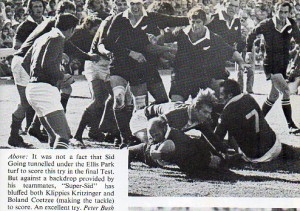
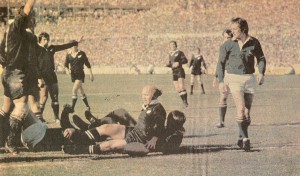
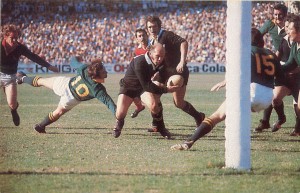


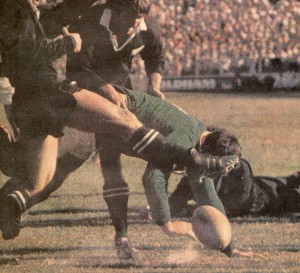
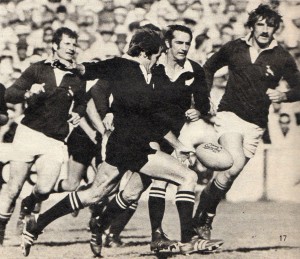
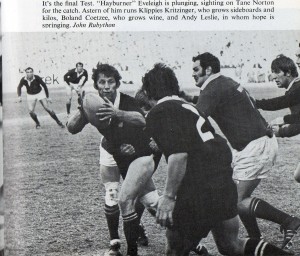
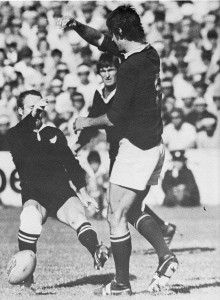
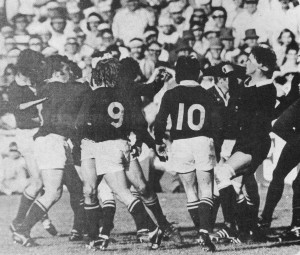
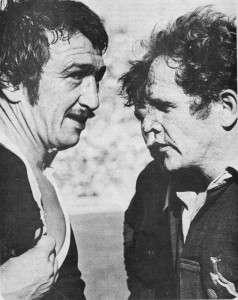
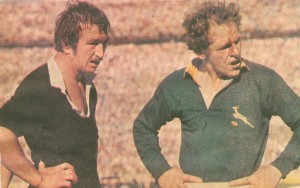
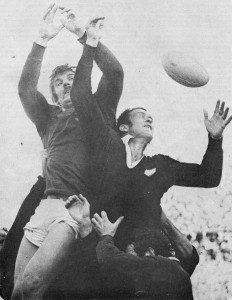

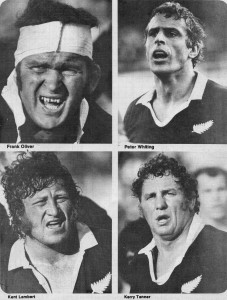
Baie dankie vir al die artikels oor die 1976 toer. Ek het dit baie geniet. Wanneer gaan jy oor die 1980 toer skryf – ek sien uit daarna?
Great stuff!!!!
Kevin, Moaner, Piston,Morne….legends! Perhaps we need some of those double-barrel sirnames back in SA rugby…..
Peter Whipp and Johan Oosthuisen, one of our best pairings ever, right next to Danie and Michael….
@ LondonBul:
My volgende reeks sal handel oor the 1956 toer. Die toer kom telkens op omrede dit so intens was en so groot invloed gehad het op die Boks/AB “rivalry” dat ek dit graag nou wil afhandel.
Users Online
Total 43 users including 0 member, 43 guests, 0 bot online
Most users ever online were 3735, on 31 August 2022 @ 6:23 pm